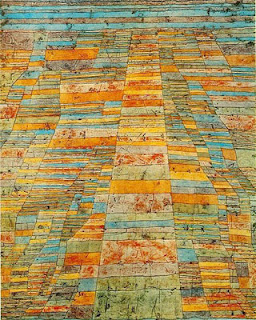 |
| Paul Klee, Mai Bild, 1925 |
This huge exhibition
of Paul Klee, L’Ironie à L’oeuvre is
the most calming exhibition I have been to in a long time. If you are in need
of an end of the week de-stress, this is the top floor of the Pompidou Centre
is the place to go. Rarely is modern art with its fragmentations and
abstractions so quiet and gentle as it is on Paul Klee’s canvases.
What I loved most was the fact that the paintings and drawings
were often incredibly angry and ascerbic, and while filled with fragmentation
and division, they are also yet executed with lightness and joy. In form, the work is very delicate: each
stroke and line is made of water colour, and they are painted often on
cardboard or paper pasted onto cardboard to accentuate ephemerality. In these
materials, there is a sense of transience to the works and, at times, it feels
as though they are going to disintegrate soon, as though they will crumble in
the hand if touched. Indeed, the Angelus
Novus (1920) a work barely known in its time, but that was made so famous by Walter Benjamin's discussion of it as the Angel of History in his Theses on the Philosophy of history, is so fragile that it is put in
a darkened room and will be returned to the lending gallery before the
exhibition is over.
Every work and every series of works is filled with
contradictions: the shapes and patterns are always geometrical, but not mathematical
or precisely drawn. In other contradictions, the sense of the childlike - but
not childish - that is everywhere in the air at the time Klee is painting,
becomes merged with the mechanical, with the machines that are also beginning
to appear everywhere in his historical moment. And Klee is also able to bring
the lightness, joy and play together with the critique of war spawned by
modernity in his midst. Indeed, there are many ironies here.
What’s also striking is the singularity of Klee’s work. Klee
does something quite different from other painters of his time, though there
are many references and resonances. It’s possible to identify his contemporaries
in the geometricality, for example, the use of line in its contrast with shape
and colour. There are also obvious references to work of Alexander Calder in
the magic and game-like nature of what Klee depicts and the way his mind works.
But then the colours used by Klee are always different from everyone else’s.
And the aggression, or what I would call the male-ness of the images that is so
prominent in his contemporaries, is absent from Klee’s painting. His images are
small, delicate, and I want to say, they are feminine in their tenderness.
| Paul Klee, Angelus Novus, 1920 |
And yet, that said, the most compelling of Klee’s works are
those produced side by side with cubism and constructivism. Though the latter can
be seen in the works produced when he was in Egypt, a time that he was more
interested in exploring the colours and textures of the desert. That is, it’s
is of course ironic that the influences of the most contrived artistic forms
appear in Klee’s paintings when he was closest to nature. I also wondered
whether the paintings’ continual verging towards two-dimensionality in Klee’s
later years a push to abstraction that mirrors the artistic response to
outbreak of World War II, or is it his own individual search? Because of these
apparently irreconcileable contradictions, while the exhibition is very calming
and peaceful, we come away with a lot of questions and I, for one, was
unsettled as well as restored.




